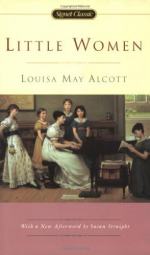|
This section contains 8,809 words (approx. 30 pages at 300 words per page) |

|
SOURCE: "Alcott's Portraits of the Artist as Little Woman," International Journal of Women's Studies, Vol. 5, No. 5, November-December, 1982, pp. 445-59.
In the following essay, Keyser discusses the functions of stories and play in Little Women—as escape, as training, and as allegory for the novel as a whole.
I
Recently an Indian friend of mine told how, as a girl growing up in Kerala, she had won a contest for a speech in English and, as a prize, received a copy of Louisa May Alcott's Little Women. She especially remembered the words of the man who presented it to her: "Read this, and be a great woman!" Initially I was struck by the irony of this injunction, for, according to my own and other feminist readings of the novel, to become a little woman is to relinquish one's dream of becoming a great one.1 But there is a sense...
|
This section contains 8,809 words (approx. 30 pages at 300 words per page) |

|


